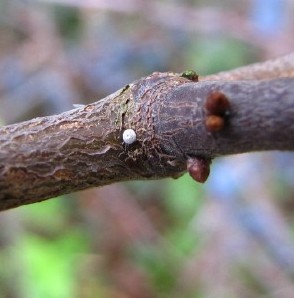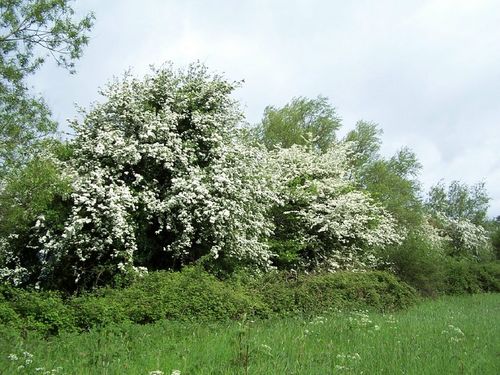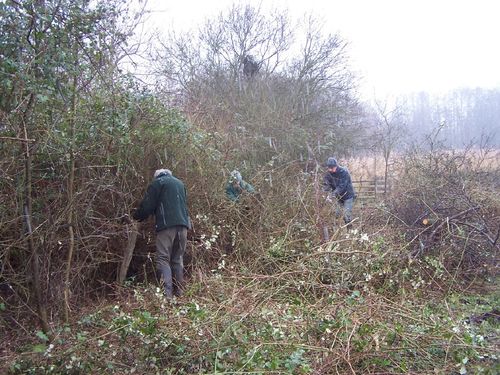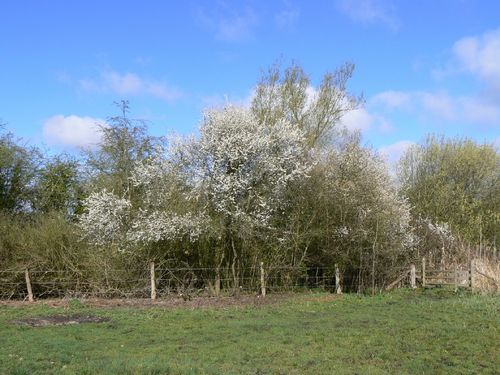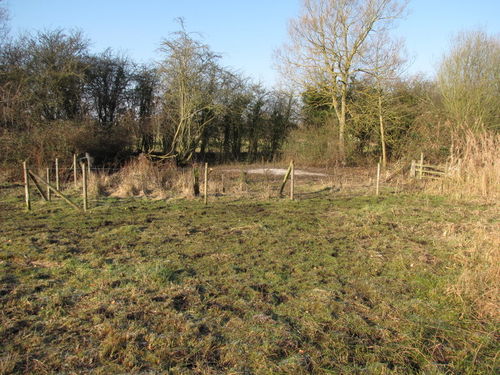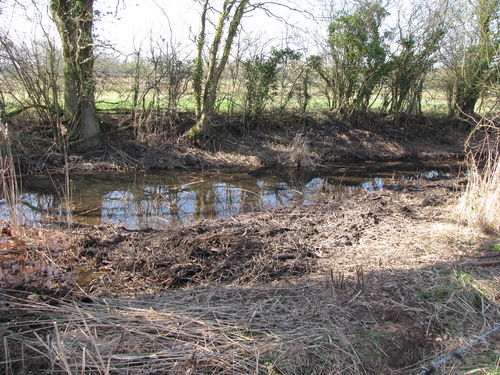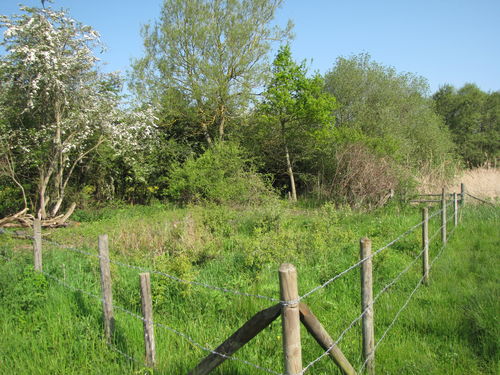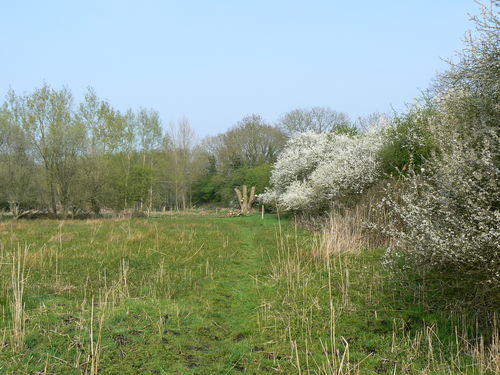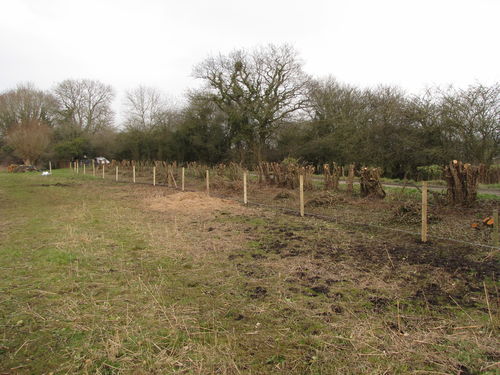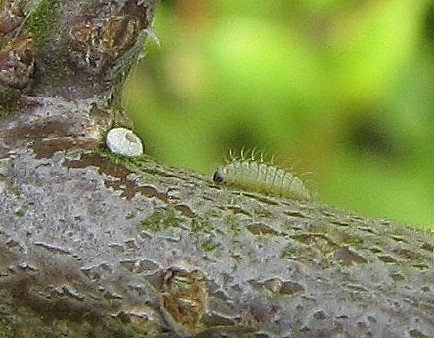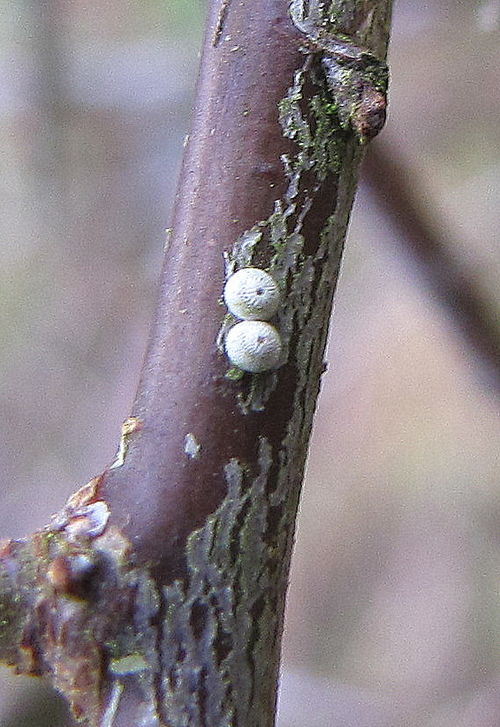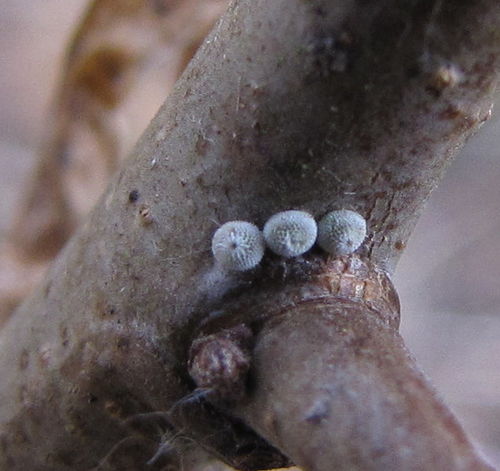Blackthorn Management at Feckenham Wylde Moor and the resultant increase in Brown Hairstreak eggs
Paul Meers
In 2008 we found a single Brown Hairstreak egg on Blackthorn (01) along the Southern boundary of the Feckenham Wylde Moor Reserve (FWM). The last previously recorded finds were in March1997 when five were found. None were recorded between these years. The reserve is owned and managed by Worcestershire Wildlife Trust (Paul Meers is the volunteer reserve manager).
Following this find in 2008 and the fact that Brown Hairstreak eggs were being found in larger numbers at nearby Grafton Wood Reserve we decided to carry out management work on the very old Blackthorn along the Southern boundary of the reserve. The photograph shows how big the hedge had grown with no visible suckers (02). It had become overgrown and covered in lichen, not good for Brown Hairstreak females laying eggs. Cutting back would encourage new suckers and confirm that the butterfly was about in our area.
On a very cold bleak day in January 2009 we started the first phase, after checking again in case there were more eggs. Volunteers cut back the old blackthorn (03). Picture (04) shows blackthorn flowering in the following spring.
During the following summer a reasonable number of small new suckers had developed and were growing out into the meadow along the fence line and that winter we found six eggs on those new suckers.
We decided to fence off the area so that grazing cattle couldn’t eat the eggs and any new suckers. The eggs eventually hatched but there was no sign of any caterpillars in May 2010.
In August 2010 I was about to climb through the fence to see if there was any Brown Hairstreak activity and typically when I was half way through the barbed-wire without my camera turned on, a lone female flew off one of the suckers. Unfortunately she moved away and did not settle again. On further investigation I found six single eggs on the new suckers. That winter, 2010, we found more eggs. Our total now stood at nine for the year.
2011 arrived and with our increasing egg numbers, albeit by only a few, we considered the possibilities of more Blackthorn clearance and in late January we decided to completely coppice the old hedge making an open area down to the ditch thus creating a sheltered microclimate with the hope that more suckers would soon fill the space (05, 06). They appeared in the spring (07).
We also decided to coppice the Moors Lane Blackthorn hedge that had never been managed since the reserve was established in the early 1980s. Thanks to Mervyn Needham and his team of volunteers who did the work (before 08, after 09). It looked harsh treatment at the time but now the hedge has grown well with plenty of suckers, many of which have Brown Hairstreak eggs on them.
It was now becoming obvious that the management was ccorrect as the area became covered with new lush Blackthorn suckers and our hopes were high for increasing numbers of eggs going forward.
During the summer we had been looking for possible Brown Hairstreak assembly trees but without success and to this day have not yet found ours. There must be one close to where we did the original work and we have a couple of possible suspects along that side of the reserve. Our egg count for 2011 was 12.
2012 arrived and the new sucker patch was now well established but becoming overgrown. We consulted Mike Williams and John Tilt about what further management we should do. We cleared the tall grasses and Cleavers, which were choking the low suckers.
Following this our egg count increased and purely by chance we found 12 eggs on a Blackthorn variety we had planted some years ago to fill a gap in the hedge along Moors Lane. This was a real bonus, as we had not considered these as food plants as they looked more like Damsons with the fruit along the main stems rather than in clumps on outer branches. The leaf is also different and there are very few thorns.
At this time ever-increasing Brown Hairstreak egg numbers were being found not only at and near Grafton Wood but also in the Feckenham area. We discovered good numbers along the Feckenham to Morton Underhill footpath, so they were obviously on the move. Our final 2012 egg count for the reserve was now up to 28.
On May 2nd 2012 I was lucky enough to find a very small caterpillar that had just hatched from a nearby egg (10). If only I had been there minutes sooner I would have probably seen it hatch. It’s all about being in the right place at the right time but you can’t be on site every day unless you are prepared to camp out. This option has not yet been ruled out!
2013 came and early on our numbers were similar to 2012, however these had been found in late summer when the females were in full egg laying mode (we have yet to see one laying at FWM and in fact we have only ever seen two on site) and leaves were still on the suckers: not the easiest time to find eggs. As winter arrived we continued to look and found more and more eggs not only on our best patch but also on the coppiced Moors Lane hedge and again on the odd blackthorn variety further up the lane. Our 2013 count rose to a massive 87 recorded including some doubles and a triple (11 and 12)..
All being well a good percentage of these eggs will successfully hatch this Spring (2014) and there will be more adult Brown Hairstreak to swell the ever increasing numbers in the County.
All our efforts over the past few years have proved without doubt that good and extensive Blackthorn management for Brown Hairstreaks certainly pays off and enables a large amount of new sucker growth which, in turn, has resulted in a significant increase in egg numbers.
Hopefully we will locate assembly trees this year (2014) and also, hopefully, I will be lucky enough to see an egg hatching.
I have been given a challenge by Harry to photograph a pupa so if you are visiting Feckenham this summer and see an elderly Warden on his hands and knees rummaging in a Blackthorn patch don’t be alarmed: it will be yours truly.
Written in March 2014.
Images
01 first Brown Hairstreak egg 2008
02 Big hedge with no suckers before management
03 Volunteers cut back the old blackthorn
04 area shown in 03 the following spring
05 Further Blackthorn clearance January 2011
06 Further Blackthorn clearance January 2011
07 Blackthorn suckers 05 area following sping
08 Before coppicing Moors Lane Blackthorn hedge
09 After coppicing Moors Lane Blackthorn hedge
10 very small Brown Hairstreak caterpillar just hatched from nearby egg
11 Double Brown Hairstreak eggs
12 Triple Brown Hairstreak eggs
